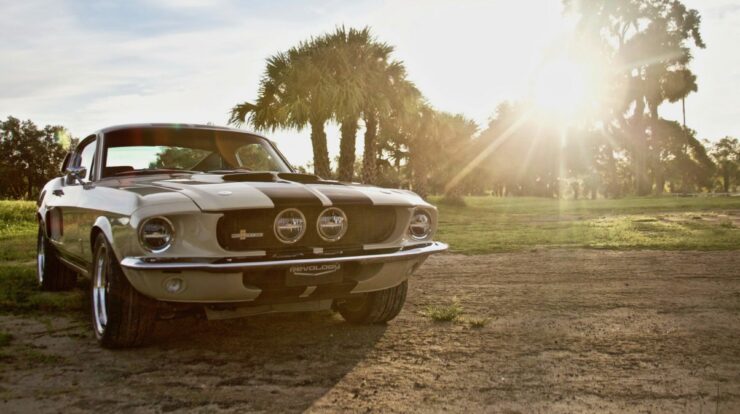
The whole Mustang line throughout its history is something worth noting due to its incredible popularity. However, there’s something uniquely notable about the 1968 Mustang GT 2+2 Fastback. If you know anything about this car, then you’re probably already aware of what this is.
This model of Mustang became iconic due to its use in the 1968 movie Bullitt. Not only did the movie help cement this car into the history book, but it also changed some of the ways auto companies interacted with Hollywood.
The appearance in Bullitt isn’t the only thing that makes the 1968 Mustang GT 2+2 Fastback iconic. It’s also a well-made car that really helped the Mustang create its legacy.
Origins
The 1968 Mustang GT 2+2 Fastback was part of Ford’s first generation of Mustangs. The first generation started with the introduction of the line in 1964 and lasted until 1973.
The Mustang was the very first pony car and created this vehicle class. The compact, sporty car was incredibly popular from the very beginning, causing Ford to work hard to keep up with demand. Sales of the Mustang far exceeded the projections Ford had made, pushing the company to increase production as the years went on.
Ford intended to limit the line to originally a Hardback and Convertible. Eventually, though, it introduced the Fastback later. Every revision of the Mustang saw changes to the power and size, getting more powerful and bigger at each step.
The oil crisis in 1973 did cause a minor setback for the line. Ford tried adjusting and introducing a Mustang II model. It did make sense in the environment at the time, but it was never popular like the other models. Many felt it strayed too far from the classic styling and design of the originals.
As an alternative solution, Ford decided to expand the engine options to give consumers a choice for what worked in their lives. Engine options also make the Mustang available to a wider audience as small engines could make for a family car, while the larger engines still catered to those pony care enthusiasts.
Notable Features
The 1968 Mustang models saw quite a few changes. The very popular console options were available for the center and overhead consoles, but they were still optional and available only at an additional cost. The air conditioner had an upgrade to go from under the dash to in the dash, something consumers were quite happy about. The original under the dash air conditioners were an add-on option that most people passed on.
The stereo system also received an upgrade, and Ford moved the rear-view mirror from the frame to the windshield.
In addition, Ford added a rear window defogger to allow for better visibility. It also updated the odometer to add in a reset button for measuring trip distances.
Ford also revised the dashboard by adding new alert lights, including door ajar, low fuel, and parking brake-engaged lights. It also had a light to remind you to use the seat belts, which was notable as a huge change in this model year.
Due to federal regulations, the 1968 Mercedes line was the first to have the shoulder belt portion of the seat belt. Previously, cars only had to have the lap belt, if any safety belt. Obviously, the introduction of the shoulder belt portion completed the belt as we know it today, which was a major step-up in automobile safety.
Beyond the seat belt safety enhancement, this model year also got an energy-absorbing steering wheel to boost safety even more. Federal regulations also required the addition of side markers, which marked another first for the 1968 Mustang and an additional safety feature. It’s safe to say the 1968 model year was the safest Mustang to date.
Rounding out changes to the interior, Ford added optional fold-down rear seats in the Fastback. It also gave the Convertible folding glass windows.
The exterior got C-stripe graphics. Ford also removed the FORD lettering from the hood and added some chrome trim. The tail lights became concave, and the rear-view mirrors were square. It also got a new gas cap.
The grille also had a change. Ford removed the two horizontal lines surrounding the emblem, and added a single band around the emblem, and one horizontal line that ran from either side of the emblem, to the grille’s sides.
According to WPLR 99.1 FM, Ford also had to make some major adjustments because it wanted to add a bigger engine to the 1968 Mustang. An increase in the car’s overall size created space for the big-block V8 engine, along with more cargo space and a roomier interior.
Increasing the size of the new model year was nothing new for Ford. This was, in fact, a common move, so consumers were expecting it. However, the introduction of new motor choices, including multiple V8 options, was something worth cheering on.
Consumers who looked at the 1968 Mustang as the perfect pony car much appreciated the range of motor options because it basically gave them a choice of power. The size increase was something they were willing to trade off, even if it pushed the boundaries of the definition of a compact pony car.
The Iconic Movie Role
What really made the 1968 Mustang GT 2+2 Fastback catapult into the history books was its appearance in the 1968 movie Bullitt. According to IMDb, Bullitt is a cop movie about an officer protecting a witness who’s about to testify against a mob boss. Of course, protecting the witness is anything but easy for the savvy cop Bullitt. Unfortunately, Bullitt doesn’t succeed in protecting the witness, who ends up dead right near the movie’s beginning.
However, Bullitt has to protect his reputation, and his boss is pushing him to bring the mobsters to justice for killing the witness on top of their other crimes. Bullitt sets off to find the hitmen who killed the witness, and it leads to a series of twists and turns that bring about a rather surprising ending where the audience discovers the witness may not be dead after all. Of course, Bullitt comes out as the hero at the end, who gets the bad guy and ends up with a girl.
Many critics say this film is a fair representation of police life in California in the late 1960s, and the movie won an Oscar for Best Film Editing. It also received many other nominations.
However, what makes this movie stand out and connects it to the Ford Mustang is the car chase scenes between Bullitt’s Mustang and the Dodge Charger driven by the bad guys. Many people say this film has the greatest movie car chase scenes of all time.
Bullitt starred Steve McQueen, who did some of his own stunts in the movie, including driving the Mustang. The actual car underwent some modifications for the movie and to fit the role it played in the movie. During the scenes, viewers see it speeding through San Francisco’s streets, which showcased its handling and capabilities. It also does a nice job of showing up the Charger, a perk for Ford since Dodge was the competition in the market.
The movie glorified the 1968 Mustang GT 2+2 Fastback, while also showing how well Hollywood was at advertising vehicles. Ford noted this movie’s impact, and set up a new division that specifically worked with Hollywood to promote vehicles in movies. It was essentially the beginning of advertising in movies, at least for the auto industry.
The film also helped to introduce the idea of shooting commercials in urban areas. Before this, commercials were always out on open roads, but showing how a car moves in an urban environment opened doors to new consumers, and became a new angle for Ford in its marketing campaigns.
McQueen mentioned in interviews how much he admired the Mustang he drove in the movie, which only helped the car’s status grow to legendary heights. Collectors still chase after their own copies of the car. The original car from the film left McQueen’s collection in the 1970s, and that owner held onto the car.
He eventually passed it down to his son, who sold the car in 2020 for $3.7 million. This sale made it the most valuable Mustang in history.
Final Notes
The 1968 Mustang GT 2+2 Fastback stood out from all the other 1960s models due to its safety features, and the engine options that allowed for wider use among a bigger consumer base. It balanced the Mustang tradition of usability with sportiness.
This Mustang is known as a fast car with excellent suspension. By today’s standards, it’s a
little unpredictable and wild due to not having electronic stability, but collectors still love it.


